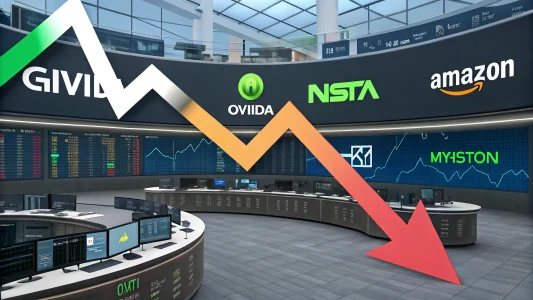I spend every week looking for the signals that can move portfolios, and three are front and center right now. Corporate earnings from big names, new housing data, and the next inflation print will shape how investors feel about risk. Each one can sway stocks, bonds, and even commodities. As CEO of LifeGoal Wealth Advisors and a CFP and CIMA professional, I focus on how these stories link to your money and your plan. The goal is simple: help you understand what matters, why it matters, and what may come next.
Investors, three things to watch this week. First, earnings. Netflix on Tuesday, Tesla on Wednesday, Newmont Mining on Thursday. Second, existing home sales on Thursday. And third, CPI inflation data on Friday.
Table of Contents
ToggleThe Three Big Signals
Earnings season offers a clean look at the health of large companies. Results from Netflix, Tesla, and Newmont Mining will give a broad read across tech, autos, energy, and commodities. Housing data arrives through existing home sales, and it speaks to demand, inventory, and affordability. Then we get consumer inflation, which matters for interest rates and valuation across the market.
- Earnings: Streaming, electric vehicles, and gold mining each tell a different story about consumer behavior, costs, and pricing power.
- Housing: The average 30-year mortgage rate sits in the low sixes. That is a step down from last year’s highs and could nudge buyers off the sidelines.
- Inflation: The CPI release may mark a fifth straight monthly increase. That puts the Federal Reserve in focus heading into its decision next week.
View this post on Instagram
What Netflix Can Tell Us About Consumers
Netflix is more than a streaming service. It is a window into how households spend on discretionary items when budgets feel tight. Management commentary on subscriber trends, churn, and pricing will help gauge demand. If growth comes from lower-priced ad tiers, that suggests consumers still want content, but they are price sensitive. If growth is broad-based, that points to stronger spending power.
Content costs and production pipelines also matter. When studios and streamers limit spending, margins can improve in the short run, but long-term growth depends on a steady slate of shows and films. Keep an eye on average revenue per user, ad-tier adoption, and international expansion. Those three metrics say a lot about the path forward.
For markets, a strong Netflix report can lift sentiment around tech and communication services. A weak one can do the reverse. Options pricing often implies wide swings, and those moves can ripple through index funds where Netflix is a meaningful weight.
Tesla and the EV Reality Check
Tesla’s numbers serve as a reality check for demand, margins, and the pace of transition in autos. Unit deliveries, pricing, and inventory tell the demand story. Cost per vehicle, battery inputs, and software revenue explain margin trends. Autonomy and energy storage offer optionality, but investors still judge the company heavily on car sales and gross margin.
Price cuts can support volume, but they put pressure on profit per unit. If costs come down through scale and manufacturing gains, margins can hold up even with lower prices. If not, earnings can feel the pinch. Watch for updates on production efficiency, the mix between higher-end and entry models, and the path for new launches.
Tesla also acts as a proxy for the EV sector. If guidance shows steady demand, suppliers and competitors can benefit. If guidance turns cautious, the read-through can weigh on lithium miners, chip makers, and other auto names.
Newmont and the Gold Surge
Newmont Mining comes at a time when gold prices have pressed into record territory. That has lifted many miners. But there is a big difference between the price of gold and the earnings power of a mining company. Investors should separate top-line price exposure from bottom-line costs.
All-in sustaining costs, or AISC, including labor, energy, and maintenance, can change the profit picture. If gold prices rise faster than costs, cash flow improves. If costs are sticky, gains can be smaller than expected. Project pipeline, reserve life, and capital discipline are key. I also look for hedging activity. Some miners lock in prices to smooth cash flow. That reduces downside if prices fall but can limit upside if prices keep rising.
Why has gold rallied? A mix of inflation worries, central bank buying, currency hedging, and geopolitical risk can push demand higher. Lower real yields also support gold. If inflation stays firm and rate cuts move closer, the case for gold remains strong. Newmont’s results will clarify how much of that price strength is flowing through to earnings.
Existing Home Sales: Rates, Supply, and the Lock-In Effect
Housing remains one of the most interest-rate-sensitive areas of the economy. With the 30-year mortgage in the low sixes, affordability has improved from last year’s peaks. That could coax buyers back. Yet the market still faces a big constraint: supply.
Many homeowners carry mortgages with rates in the 2% to 4% range. That “lock-in effect” keeps listings low because selling means taking on a much higher rate. Limited supply supports prices, even as monthly payments remain high for new buyers. The result is a slower, tighter market rather than a deep decline.
What to watch in the data: sales pace, months of supply, median price, and days on market. A pickup in sales with stable inventories can lift builder sentiment and materials stocks. A soft report can weigh on sentiment and pull mortgage rates into focus again.
Refinance activity also matters. If rates drift down, homeowners may move faster, creating more listings and mobility. That process takes time. It is one reason the housing cycle often lags moves in broader rates.
CPI: Another Step Higher?
Friday’s CPI report arrives with a simple question: are price pressures cooling or not? The hint this week is whether we see a fifth straight monthly increase. Headline CPI reflects energy and food swings. Core CPI, which strips those out, gives a steadier read on trend inflation.
Key drivers to watch include shelter inflation, services ex-housing, and goods prices. Shelter inflation often lags private rent measures by several months, so a slow fade is common even after market rents ease. Services inflation ties to wages, so it can be sticky. Goods inflation can swing with supply chains and demand for big-ticket items.
If CPI comes in hot, the market may price fewer or later rate cuts. Yields could rise, pressuring long-duration assets like growth stocks. If CPI cools, yields could slip and risk assets may get a lift. The path for rates sets the tone for sector leadership across the market.
What It Means For The Fed
The Federal Reserve meets next week. Policymakers will have fresh CPI data and a view of labor conditions. Their task is to weigh progress on inflation against the risk of slowing growth. If inflation runs higher for longer, they may keep rates elevated. If inflation cools, they can shift toward easing in a measured way.
Market pricing changes quickly. A single CPI report will not decide the whole year, but it can move the needle on timing. Watch the Fed’s statement and press conference language. Phrases around “data dependence” and the balance of risks will be key. The Fed wants clear evidence that inflation is moving toward its target, and it will react to the trend rather than one-offs.
How These Signals Fit Together
These three stories tie to one theme: the cost of money. Corporate earnings reflect demand and pricing power. Housing shows how rates shape real-world choices. CPI anchors the interest-rate debate. Together, they guide sector moves and index direction.
A strong earnings week and a cooler CPI print could push yields lower and boost growth stocks. A weak earnings week and a hot CPI print could do the opposite. Housing sits in the middle as a gauge of consumer strength and credit conditions.
Practical Takeaways For Investors
I plan for a range of outcomes and focus on risk management. Concentrated bets on any single print can backfire. A diversified mix and a clear plan help handle swings in both directions. Here is how I frame it:
- Know what you own. If your portfolio leans toward long-duration assets, interest rate moves matter more.
- Separate noise from signal. One report can move markets, but trends matter more.
- Watch cash flows. For companies and households, cash generation and flexibility are key in a higher-rate world.
- Use a policy for rebalancing. Let volatility work for you by trimming winners and adding to laggards within your plan.
What I Will Be Watching In Each Report
For Netflix, I will focus on subscriber adds by region, ad-tier adoption, churn, and average revenue per user. Commentary on content spending and licensing strategy matters for long-run margins. If growth comes with better unit economics, that is a constructive sign.
For Tesla, I will track deliveries versus production, gross margin ex-credits, and the pricing mix. Updates on manufacturing efficiency, energy storage growth, and the status of new models will help shape the margin path. A clear plan for scaling while protecting profitability would be a positive signal.
For Newmont, I will look at AISC, free cash flow, and balance sheet strength. Project updates, reserve life, and any hedging disclosures will show how sensitive results are to gold prices. High prices can be helpful, but discipline makes the difference.
In housing, I will watch the sales pace relative to inventory. If sales rise while inventory stays tight, prices can remain firm. If inventory builds, pricing power may soften. Mortgage rate trends will set the tone into the summer and fall buying seasons.
On CPI, I will focus on shelter, services ex-housing, and goods. A broad cooling would support a friendlier rate path. A sticky services print would argue for patience from the Fed. Either way, the trend across several months will matter most.
Market Impact: Scenarios To Consider
Here are simple scenarios I am weighing. These are not predictions, but useful guides for planning risk and expectations:
If earnings beat and CPI cools, watch for:
- Lower Treasury yields and stronger performance in tech, communication services, and small caps.
- Improved breadth as cyclicals catch a bid on better growth expectations.
- Gold holding gains if real yields do not rise, with miners benefiting if costs stay in check.
If earnings miss and CPI runs hot, watch for:
- Higher yields and pressure on long-duration equities.
- A defensive tilt to health care, utilities, and consumer staples.
- Gold resilience if inflation concerns persist, but margin pressure for miners if costs rise.
If results and CPI land near expectations, watch for:
- Stock-specific moves to dominate index action.
- Continued chop in rates until the next labor and inflation data points.
- Housing activity to improve only slowly unless mortgage rates fall further.
Final Thought
This week’s events give us a clean read on how companies, households, and prices are adjusting. Earnings speak to profits and efficiency. Housing shows the tug-of-war between rates and supply. CPI sets the tone for the Fed and, by extension, the market’s appetite for risk. I will share updates as the data hits and break down what it means for strategy, risk, and timelines. Stay patient, stay disciplined, and let the data guide the next decision.

















